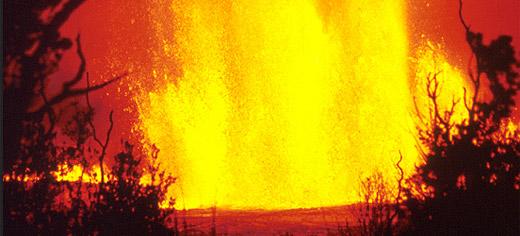A new study on the connection between earthquakes and volcanoes took its inspiration from old engineering basics. Future applications of these results may enable better predictions of the likelihood of a volcanic eruption for communities affected by an earthquake.
If you swirl wine in a glass too strongly, the wine crashes against the sides and spills over the top. The same swirling and crashing, technically termed “sloshing,” happens when transporting liquids on trucks or ships. Large liquid containers must be specially designed to avoid damage as the vehicle shakes and the liquid sloshes. Strong earthquakes can even damage large petroleum tanks.
When earthquakes shake the ground, the hot, molten rock beneath the Earth’s surface can slosh and cause the magma to erupt from volcanoes.
“I wondered how earthquakes shake magma underground. It is well known that some earthquakes can trigger volcanic eruptions, but exactly how earthquakes and volcanoes are connected is still controversial. Our work adds a new event — earthquake induced sloshing — to the list of possible triggers of volcanic eruptions,” said Atsuko Namiki, Ph.D., associate professor at Hiroshima University and first author of the paper.
Boxes filled with simple syrup represented a volcano’s molten insides and a precision shake table represented an earthquake.
“It might be surprising that ordinary syrup can represent a volcano’s magma, but the way syrup moves is quite similar to magma,” said Namiki.
Namiki visited the GFZ German Research Centre for Geosciences to use the specialized equipment available there and collaborate with co-authors of the research paper, Dr. Eleonora Rivalta, Dr. Heiko Woith, and Dr. Thomas R. Walter.
“The side-to-side shaking we used represented earthquakes of different severities and intensities,” said Namiki.
A super-fast camera and advanced mathematical calculations were used to analyze video recordings of the model volcanoes.
Air bubbles and small plastic flakes added to the syrup represented the bubbles of gas and solid crystals floating in magma.
During “earthquakes” of certain strength and speed, sloshing popped bubbles inside the syrup. In an actual volcano, popped bubbles release volcanic gas into the atmosphere. This decrease in pressure within the volcano can then trigger an eruption.
“In sealed containers, sloshing only occurs when there is empty air space where the liquid has room to move. Most magma reservoirs in volcanoes are full and sealed, but sloshing still can occur if there are layers of magma of different densities, similar to oil floating on water,” said Namiki.
Sloshing mixes the layers, which can trigger the growth of new bubbles that eventually pop and create more violent eruptions.
The research team analyzed the syrup’s motion and created a model to describe the conditions under which bubbles in real magma could pop and potentially cause actual volcanic eruptions.
Buildings suffer greater damage when the building’s resonant frequency matches the rate of shaking by the earthquake. Similarly, volcanoes have resonant frequencies and certain earthquakes will more significantly slosh magma inside a volcano.
The shape of the inside of the volcano and the location, size, and number of bubbles all influence how a volcano might behave after an earthquake. Depending on the volcano, some earthquakes could trigger volcanic eruptions within weeks, others might take years.
The results indicate that the historically documented increase in the number of volcanic eruptions after an earthquake has an explanation and is not just coincidence.


